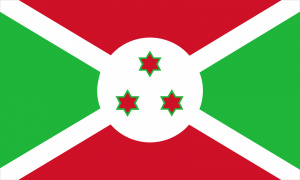Language/Rundi/Culture/Burundi-Timeline
Jump to navigation
Jump to search
Rate this lesson:
Historical Timeline for Burundi - A chronology of key events
- Between - 1000 and - 200 before our era ➡ Appearance of a population center of bantouphones populations in the Great Lakes region.
- Around 1680-1700 ➡ Foundation of the Kingdom of Burundi by Ntare Rushatsi.
- From the 1820s ➡ First caravans of Zanzibari traders in search of ivory and slaves on the coast of Lake Tanganyika.
- Around 1850 ➡ Advent of the mwami Mwezi Gisabo (until 1908). First European explorations (Burton and Speke in 1858, Livingstone and Stanley in 1871).
- 1890 ➡ Birth of the German East African Protectorate (in 1899, Urundi, Ruanda, Tanganyika).
- 1897 ➡ Foundation of the city of Usumbura (Bujumbura) by the German military.
- June 6, 1903 ➡ Treaty of Kiganda consecrating the submission of Mwezi Gisabo to the Germans.
- May 30, 1919 ➡ Ortz-Milner Convention between Belgians and British. A mandate is entrusted by the League of Nations to Belgium for the administration of Ruanda-Urundi.
- August 21, 1925 ➡ Organic law on the government of Ruanda-Urundi establishing the administrative union of this territory with the neighboring colony of the Belgian Congo.
- 1929-1933 ➡ Administrative reorganization of Urundi (eviction of Hutu leaders).
- December 13, 1946 ➡ Guardianship Agreement on Ruanda-Urundi between Belgium and the UN.
- July 14, 1952 ➡ Decree on the political reorganization of Ruanda-Urundi. Creation of councils at different levels (chiefdoms, sub-chiefdoms, territories, Higher Council of the country).
- 1959 ➡ Belgian government declaration on the political future of Ruanda-Urundi and creation of the first political parties. In Rwanda, it is the "Hutu social revolution".
- December 25, 1959 ➡ Interim decree on political organization in Ruanda-Urundi. Beginning of political and administrative reforms leading to a certain democratization of the country.
- Nov 15-Dec 8 1960 ➡ Municipal elections by direct universal suffrage of men. Victory of the "democratic" parties (close to the Belgian supervision).
- September 18, 1961 ➡ Legislative elections by direct universal suffrage, controlled by the UN. Victory for the Uprona party, leader of the independence parties.
- October 13, 1961 ➡ Assassination of Prince Louis Rwagasore, leader of the Uprona.
- July 1, 1962 ➡ Separate independence of Burundi (kingdom) and Rwanda (republic).
- 1965 ➡ Assassination of Hutu Prime Minister Pierre Ngendandumwe, in January. In May, legislative elections consecrating a strong presence of Hutu deputies. In October, the first serious ethnic crisis.
- 23-28 November 1966 ➡ The Uprona becomes a single party. The monarchy, then represented by the young Charles Ndizeye (mwami under the name of Ntare) is abolished and Captain Michel Micombero proclaims the 1st Republic.
- April-June 1972 ➡ The "scourge" (ikiza): killings against Tutsi, followed by the selective and massive massacre of Hutu elites (up to 200,000 dead). Assassination of the last king Ntare at the start of these "events".
- November 1, 1976 ➡ Military coup and proclamation of the Second Republic, chaired by Jean-Baptiste Bagaza.
- September 3, 1987 ➡ Military coup and proclamation of the Third Republic by Major Pierre Buyoya.
- August 1988 ➡ Massacres of Ntega and Marangara (± 20,000 dead). Formation of a government of "national unity".
- 1991-1992 ➡ Adoption of the "Charter of National Unity" and new Constitution establishing a multi-party system and guarantees for public freedoms.
- June 1 and 29, 1993 ➡ Presidential and legislative elections. Victory for the Sahwanya-Frodebu party and election of a Hutu President, Melchior Ndadaye.
- October 21, 1993 ➡ Assassination of President Ndadaye and start of large-scale massacres in the interior of the country.
- April 6, 1994 ➡ Death of President Cyprien Ntaryamira in the attack on Rwandan President Habyarimana's plane. Beginning of the Tutsi genocide in Rwanda.
- 1994-1995 ➡ Intensification of the civil war and development of armed rebellions. Ethnic cleanings and "dead city" days in Bujumbura.
- July 25, 1996 ➡ Coup d'Etat by Pierre Buyoya. Embargo against Burundi decreed by neighboring countries (lifted in January 1999).
- August 28, 2000 ➡ Signature of the Agreement for Peace and Reconciliation in Arusha (Tanzania).
- November 1, 2001 ➡ Establishment of a transitional government. Pierre Buyoya (Tutsi, Uprona) is the first president.
- April 2002 ➡ Deployment of an African intervention force by the African Union (MIAB-AMIB), replaced by a UN force in May 2004 (Onub, then Binub).
- May 1, 2003 ➡ Transmission of transitional power to Domitien Ndayizeye (Hutu, Frodebu).
- Oct.-Nov. 2003 ➡ Power-sharing agreements between the transitional government and the CNDD-FDD armed movement.
- 2005 ➡ Constitutional referendum in February then municipal, legislative, senatorial and hill elections won by the CNDD-FDD. In August, Pierre Nkurunziza was elected President of the Republic.
- 2009 ➡ Agreement between the Burundian government and the Palipehutu-FNL.
- 2010 ➡ Municipal, legislative, presidential, senatorial and hill elections, won by the CNDD-FDD, but boycotted after the municipal elections by most of the opposition parties united in an Alliance of Democrats for Change (ADC Ikibiri). Pierre Nkurunziza is returned to the supreme magistracy, the CNDD-FDD majority is overwhelming in the national assembly.
- 2015 ➡ Municipal, legislative, presidential, senatorial and hill elections.
World Timelines[edit source]

